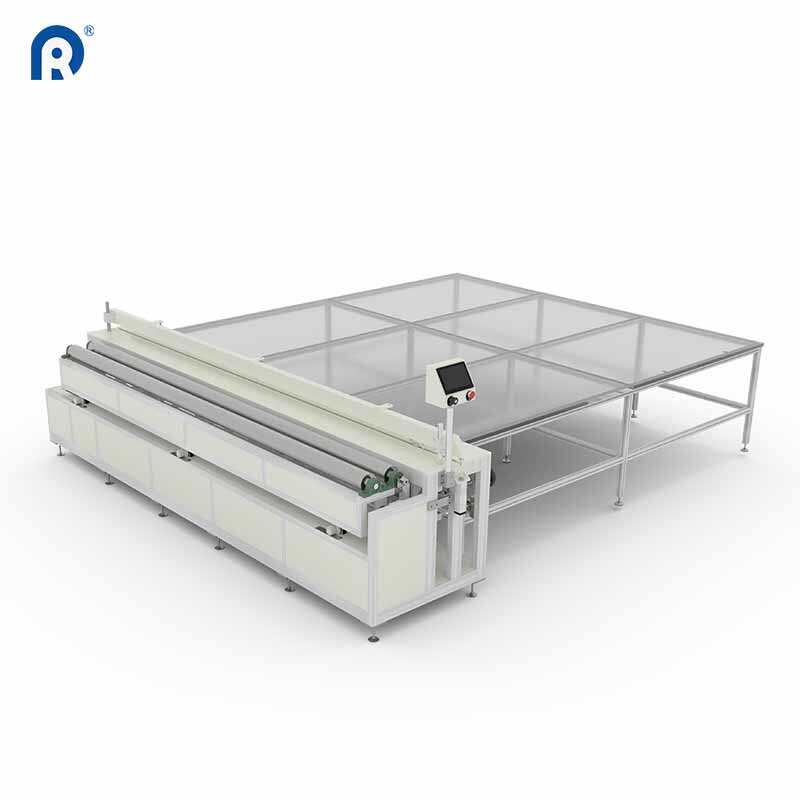A roller blinds cutting table is a specialized worktable designed to trim window roller blinds and other fabrics to precise lengths before installation. These tables are essential for both small workshops and large-scale production, ensuring accuracy, efficiency, and high-quality results.
Types of Roller Blinds Cutting Tables
1. Curtain PLC Cutting Table with Lay While Slider
This advanced table uses a programmable logic controller (PLC) to automate and optimize the cutting and laying process. The PLC slider ensures precise, repeatable cuts and can handle not only roller blinds but also curtains and large fabrics, making it a versatile choice for various textile applications.
2. Ultrasonic Blind Cutting Table with Heater
Equipped with ultrasonic technology and a built-in heater, this table delivers clean, fray-free cuts on a wide range of fabrics. The ultrasonic blade seals the edges as it cuts, preventing unraveling and ensuring a professional finish.
3. Curtain Electric Cutting Table Without Lay
This electric cutting table offers a spacious, unobstructed surface, allowing users to maneuver materials freely. It’s ideal for custom-sized cuts and boosts productivity by providing more working space.
4. Multiple Lay CNC Cutting Table
Featuring computer numerical control (CNC), this table automates the cutting process for maximum precision. Its multiple layers (lays) enable simultaneous processing of several materials, increasing efficiency and throughput in high-volume settings.
5. Other Types
Additional options include straight blade cutting tables, curtain electric cutting tables with lay, and inline cutting and stitching tables, each catering to specific production needs.
Specifications of Roller Blinds Cutting Tables
- Size: Table dimensions determine the maximum blind size and workspace suitability. A typical 5x3 ft table accommodates material widths up to 54 inches.
- Construction: Durable steel frames with powder-coated surfaces offer stability and longevity, while lighter materials like particle board are more portable.
- Cutting Mechanism: Options include guillotines for stiff materials and straight cutters for fabrics.
- Supporting Tools: Integrated rollers and clamps help secure and maneuver materials for accurate cuts.
- Power: Electric tables typically use 220V AC, with power requirements varying by table size.
- Cutting Capacity: Designed for materials up to 8mm thick and weights up to 10kg.
- Cutting Accuracy: High-precision tables offer millimeter-level accuracy for perfect results.
- Accessories: Optional jigs and fixtures provide flexibility for custom cuts and shapes.
Maintenance Tips for Cutting Tables
- Regularly check and tighten all nuts, bolts, and screws.
- Clean surfaces, rails, and cutting edges to prevent dust buildup.
- Store in a dry, ventilated area away from children and direct sunlight.
- Lubricate moving parts to maintain smooth operation and cutting efficiency.
Common Uses of Cutting Tables
- Roller Blind Industry: Cutting large fabric rolls into precise sizes for roller blinds.
- Furnishing Fabrications: Cutting materials for curtains, upholstery, and other furnishings.
- Carpentry: Sizing wood and other materials, leveraging similar skills as blind cutting.
- Graphic Design: Digitally cutting vinyl, paper, and cardboard for custom designs and signage.
How to Choose the Best Roller Blinds Cutting Table
1. Analyze Business Needs: Consider fabric type, blind size, and production volume.
2. Set a Budget: Manual tables are cost-effective for small businesses; automated tables suit larger operations.
3. Prioritize Accuracy: Look for clear measuring systems and smooth surfaces for precise cuts.
4. Assess Workforce Skills: Match table complexity to staff experience and training.
5. Evaluate Space: Choose a table size that fits your workspace without crowding.
6. Check Safety Features: Ensure tables have emergency stops, protective enclosures, and safety sensors.
Frequently Asked Questions
Q: What types of blinds can be cut with a roller blinds cutting table?
A: These tables are designed for roller blinds but can also cut vertical, venetian, blackout, sunscreen, zip blinds,roman, and pleated blinds.
Q: Can a roller cutting table be used for other window fittings?
A: Generally, no. They are specialized for roller blinds and similar types; using them for other fittings may cause damage or inaccurate cuts.
Q: Is custom cutting possible with these tables?
A: Yes. Many tables support custom cuts, including notches, curves, and holes, using specialized jigs and fixtures.
Q: Are roller blind cutting tables easier to use than standard tools?
A: Absolutely. They offer greater speed, accuracy, and efficiency, reducing errors and saving time.
---
Conclusion
Choosing the right roller blinds cutting table is crucial for achieving precise, efficient, and safe cutting operations. By understanding the different types, specifications, and features, you can select the best table to meet your business needs and ensure high-quality results for every project.
